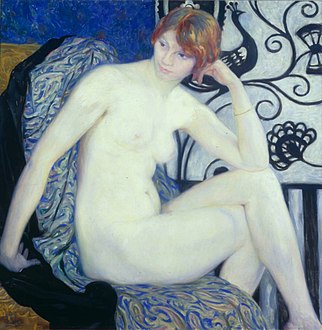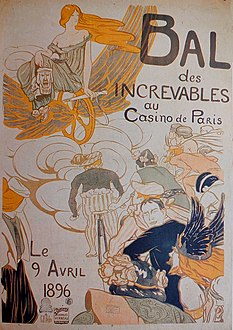Clémentine-Hélène Dufau
This article includes a list of general references, but it lacks sufficient corresponding inline citations. (April 2017) |
Clementine-Hélène Dufau | |
|---|---|
 Self-portrait (1911) | |
| Born | 18 August 1869 Quinsac, Gironde, France |
| Died | 18 March 1937 (aged 67) Paris, France |
| Nationality | French |
| Known for | Painting |
Clementine-Hélène Dufau (18 August 1869,
Biography
Her father was an entrepreneur of
She was in poor health as a girl and had to spend many hours in bed, during which she began to draw. After her sisters were all married, she wanted to study art. Her parents decided to sell their interest in the vineyard and moved to Paris with her in 1888.
She enrolled at the
By 1905, she was a well-established artist; working with
Later career
Her career continued to expand. She received a commission from the government for decorations at new additions to the Sorbonne and portraits of numerous personalities. In 1911, she built a villa in Basque Country, but had to sell it in 1926 when her financial situation began to deteriorate. She set up a studio in Antibes, facing the sea. It was later occupied by other artists; notably Nicolas de Staël and the sculptor, Abel Chrétien, both of whom died there.
She became an adept of René Guénon and a passionate admirer of the young Krishnamurti. In 1932, she wrote Les Trois Couleurs de la Lumière, in which she expounded her esoteric vision of art. In addition to Guénon, she was inspired by the theories of the aesthetician, Charles Henry, and the gnostic, Paul-François-Gaspard Lacuria (1806-1890), author of The Harmonies of Being. Her work was also part of the painting event in the art competition at the 1932 Summer Olympics.[2]
She was finally forced to leave Antibes and rent her workshop. She returned to Paris and exhibited at the Salon of the
Selected works
-
Portrait of
Maurice Rostand -
Intimate Vision
-
Bargemen's Children
-
Poster for the
Casino-de-Paris -
Advertising poster for "La Fronde" (1898)
-
Madame Pol Neveu, 1910, Museum of Fine Arts, Reims
Sources
- ^ "Clémentine-Hélène Dufau (1869-1937)". Data.bnf.fr. Retrieved 11 September 2017.
- ^ "Clémentine-Hélène Dufau". Olympedia. Retrieved 2 August 2020.
- Elmar Stolpe: Dufau, Hélène. In: ISBN 3-598-22770-1, pgs.267–269.
- H. Vollmer: Dufau, Clémentine Hélène. In: Ulrich Thieme, Felix Becker, Allgemeines Lexikon der Bildenden Künstler von der Antike bis zur Gegenwart. Vol.10, E. A. Seemann, Leipzig 1914, pg.82–83.
Further reading
- Mayi Milhou, De lumière et d'ombre : Clémentine-Hélène Dufau, Éditions Arts, 1997 ISBN 2-911059-03-4
External links
- Encore une femme peintre méconnue : Clémentine Hélène Dufau, from the journal of René Gimpel @ Le Petit Renaudon BlogSpot.






